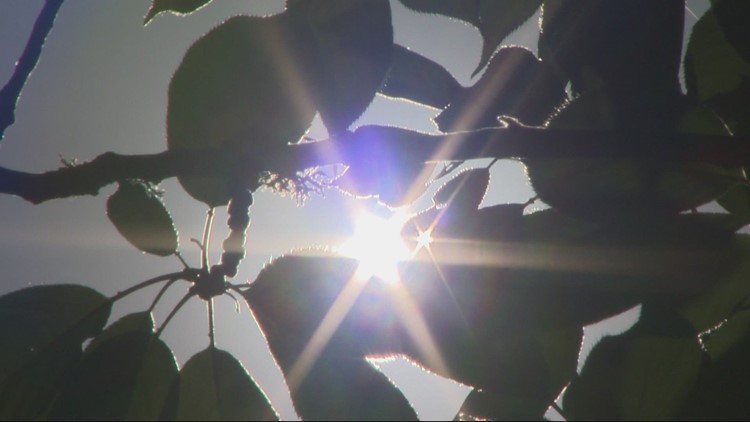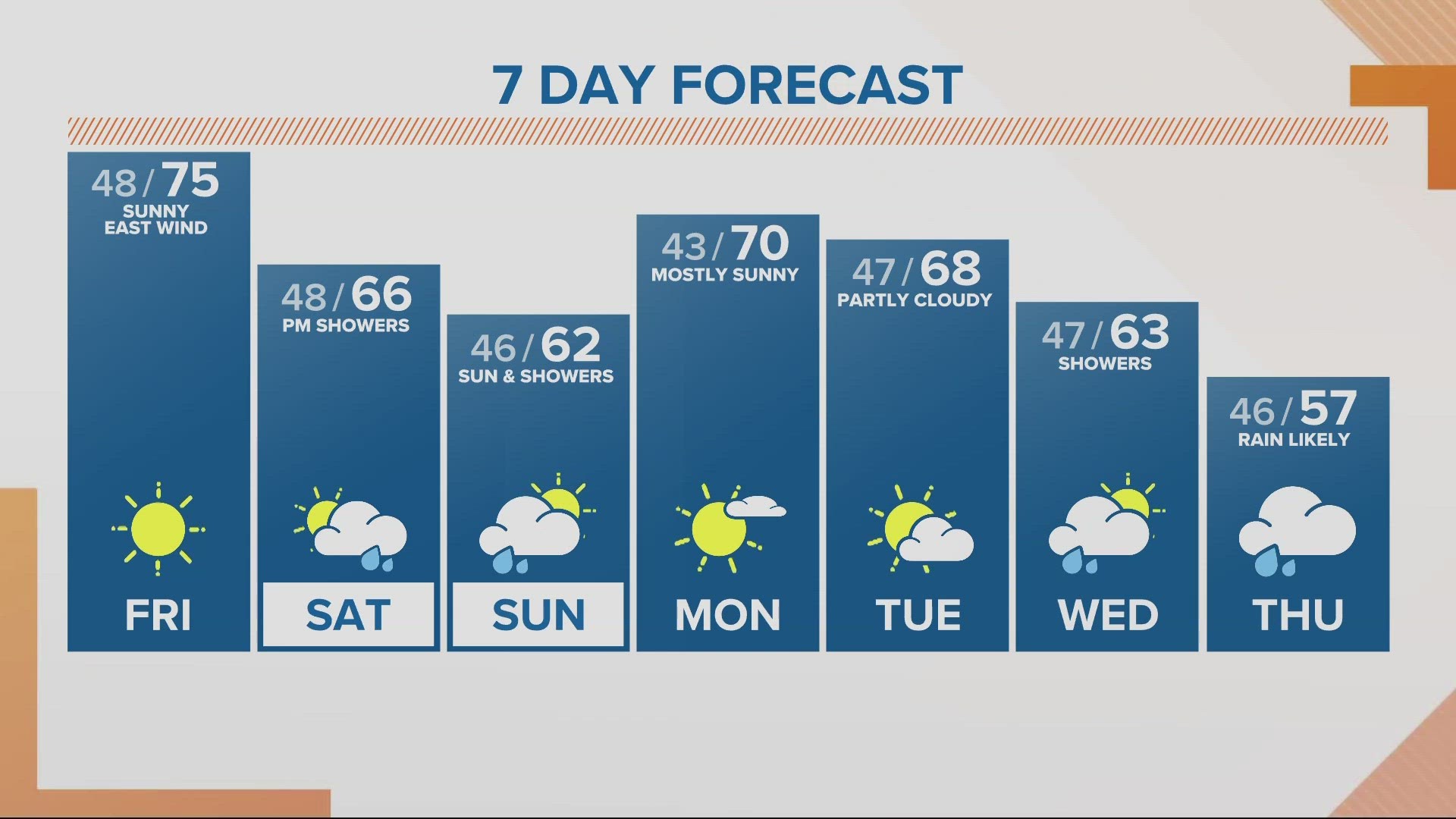PORTLAND, Ore. — The trees in Oregon weren’t ready for the heat that sweltered over the state in late June.
The heat dome brought record temperatures for three consecutive days across the Pacific Northwest, and researchers are still working to tally the damage several months later.
The devastating human toll was immediately clear, as more than 100 people died in Oregon, most of whom were in Multnomah County, alone and in dwellings without fans or air conditioners. Hundreds more were made ill across the region by the high temperatures.
The heat had its effect on animals, as well. In eastern Oregon, dozens of baby hawks jumped from their nests to try to avoid the heat.
But some victims of the sky-high temperatures were less obvious in the immediate aftermath: Oregon’s forests. That was the subject of a meeting of tree experts -- foresters, silviculturists and botanists -- who gathered virtually last week to discuss the what’s to come for the state’s scorched treescapes.
“These trees are not acclimated to this kind of heat,” said Kat Olson, lead silviculturist at GreenWood Resources, an asset management company that oversees more than 150,000 acres of forest in Oregon and Washington. “We know there will be significant growth impacts.”
That was the goal of the Friday meeting, convened by the Oregon State University College of Forestry, to begin looking at how excessive heat affects one of Oregon’s most valuable and beloved natural resources. Some of the scorched trees will undoubtedly recover -- and scientists at this point can’t say how many -- but the long-term prognosis for the state’s forests after a heat wave of such epic proportions will require more in-depth research.
An unprecedented heat event
A strong ridge of high pressure began building over the Pacific Northwest during the last week in June. The ridge forced air in the atmosphere down, compressing it and warming it in a phenomenon known as subsidence. That warm air was then trapped in place by the high pressure, forming a heat dome.
The heat dome coincided with a slight offshore flow with winds coming from the east, pulling dry air from the high desert of southeastern Oregon, which heated more easily than air with higher moisture content. That air, too, was forced downward as it blew over the west-facing slopes of the Cascades, further heating as it was compressed.
Oregon and much of the western U.S. were also coming out of an exceptionally dry spring, leaving plants and soil bereft of the moisture that usually evaporates into the atmosphere and provides a modest cooling effect.
All of this was taking place right around the summer solstice, so the Pacific Northwest was absorbing more of the sun’s energy than it did at any other time of year.
The combination of all of those factors combined to make for record-breaking heat across Oregon, Washington and parts of British Columbia.
In the wake of the event, climate change experts said a heat dome of that severity was made 150 times more likely because of global warming.
A hard-to-quantify problem
John Nohr, the fire chief for parts of Clark and Cowlitz counties in Washington, was driving down Interstate 5 when another firefighter asked if he’d noticed the trees.
It was June 29 — one day after the hottest day in both Portland’s and Vancouver’s histories — and Nohr turned to see the needles on every fir tree had turned brown on the side facing the sun, seemingly overnight. On Interstate 205, he saw the same.
Daniel DePinte, a forest health specialist with the U.S. Forest Service, needed to know more about how Oregon’s trees had fared than could be observed from the side of the highway. He had begun receiving reports of damage to trees soon after the heat dome dissipated across numerous species, including Douglas fir, ponderosa pine, giant sequoia, western red cedar, spruce, maple and western hemlock.
Thermal imaging from some forests near the coast showed bark temperatures near 122 degrees.
After visiting several sites on the ground, DePinte and other researchers saw the damage for themselves. Many trees had scorched leaves and needles, mostly on the south and west sides, which were fully exposed to the sun for the hottest parts of the day. The nature of the damage quickly helped them rule out drought or pests as the cause.
He began surveying from a small plane above the forests of the Willamette Valley and the Coast Range, flying in grid patterns and mapping where the trees were visibly scorched.
In his limited surveys, DePinte said at least 229,000 acres showed some damage, with about half rated as “very severe.” He also noted that surveying by plane is inherently limited in scope, and the damage was likely much more widespread.
“I knew we were not getting 100% of the damage,” DePinte said.
All plants have an optimal growing temperature, and when the temperature is exceeded, photosynthesis slows and they stop respirating. The high temperatures of the heat dome, coupled with the ongoing drought in the Pacific Northwest, likely pushed some trees to the brink, said Bill Hammond, an ecophysiologist from the University of Florida.
“Having a heat wave atop a drought is like putting your foot on the gas ... toward tree mortality,” Hammond said.
Not just natural forests
Olson, the silviculturist with GreenWood Resources, began similarly surveying GreenWood Resource’s forestlands after the heat dome. Her team looked at about 220 stands of trees spread over 17,000 acres.
A quarter of the stands had moderate to severe damage on at least 40% of the trees, she said, with the worst damage on southwest facing slopes closest to the coast. Older trees fared better, she said, while many saplings did not survive.
“If you were a poor little baby Douglas fir, you got pretty much zapped,” she said. “They are just sticks now.”
Olson said her company would likely be planting between 600,000 and 800,000 additional trees this year to make up for the expected mortality.
Chal Lundgren, a Christmas tree specialist at Oregon State University, said similar impacts were seen at Christmas tree farms across the region. Because most Christmas tree farms are run without irrigation and the Pacific Northwest was already suffering through a drought, many young trees did not survive.
Older trees, especially the Noble, Grand and Fraser firs, suffered some scorch and on some trees, the leader -- the top branch atop which a topper is generally affixed for Christmas -- were bent and limp.
What remains to be seen, nearly everyone at the symposium agreed, is what the long-term prognosis will be for trees damaged by the heat dome. For that, time, and more research, will tell.



